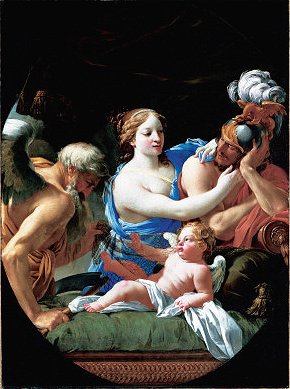 |
|
Time Discovering the Love of Venus &
Mars
by Simon Vouet, French 1590-1649
SN 360 Oil on Canvas
Artist:
Simon Vouet was the leading French painter in the first half of the 17th century. He spent
fourteen years (1613-27) in Italy ( primarily Rome) where he achieved a considerable
reputation, being made President of the Roman Academy of St. Luke in 1624. In 1627 King
Louis XIII recalled Vouet to Paris and made him his court painter where he dominated
French painting ; challenged only by Poussin for a short time upon the latter's return to
Paris in 1640-42.
Vouet had a large workshop and many artists who were to become the
important French painters of the future were trained by him. Charles le Brun, Eustache Le
Sueur and Nicolas and Pierre Mignard were among his pupils. He was the most influential
French artist of his generation and without him Paris would never have become one of the
artistic capitals of Europe.
Vouet painted religious and allegorical works as well as portraits and was
employed on many important decorative schemes. While in France his style evolved from
strong contrasts of light and shadow and the rich color of the Italian style to planes of
clear color set one beside another across the canvas. |
He had a very busy and prosperous career as he had developed a compromise style which
proved to be to the French public's taste at a time when French painting was at a low ebb.
While his early work was influenced by Caravaggio, this newly developed style tempered the
Baroque with Classicism. It fell between the dramatic naturalism of the Caravaggesque and
the Classicism of Guido Reni and Domenichino.
Subject:
The painting shows Venus and Mars enjoying their illicit love affair. This story is
recounted in Ovid's Metamorophoses and was a popular subject for painters throughout the
17th century. Venus, goddess of love, is married to Vulcan but carries on a love affair
with Mars, the god of war. They were discovered in the act and Vulcan was told of it.
Vulcan then fashioned a net of invisible chains, nets and snares which he set around his
bed. The next time Mars and Venus lay down together upon the couch they were caught in the
chains and held fast in the act of embracing. All the gods were then invited in to witness
the adultury of Mars and Venus.
Painting:
The painting shows a seductive Venus as she caresses a rather surly but enchanted Mars.
Cupid, Venus' son, in the foreground seems to behave like a mortal child. Chronos or Time
/ Death is seen at the left holding his scythe and casting a net over Cupid. The figures
are seen against a dark background which is typical of many of Vouet's paintings.
The moral of the picture is the victory of Time (and by extension Death)
over love and beauty. Chronos in casting his net over Cupid alludes to Vulcan's later
capture of the unlucky pair. The picture is therfore an allegory of Love vanquished by
Time.
The painting obviously belongs to Vouet's Paris period. The vivid colors ,
the skillful linking of the gestures and the play of glances between the couples would
indicate a date of about 1640. The masterful execution and expressive palette resulted in
a charming painting.
Historical Context:
French painting had been dominated in the first quarter of the 17th century by a form of
Late mannerism. It was the arrival of Vouet in 1627 that inaugurated a new movement in art
- a style of Italian painting as yet unknown in France.
Painted in 1640, this work was done by Vouet at the time of Poussin's
unhappy return to Paris. Vouet had dominated the artistic life of the city at this point
and could only be rivaled by Poussin. The latter was to leave Paris a few years later
bitterly disappointed by his lack of success at court, whose taste and politics he did not
understand but which Vouet both understood and capitalized upon. After Poussin's
departure, Vouet continued as the major force in French painting.
Vouet's colorful decorative style and Poussin's classicism continued to
rival one another in France from the rococo thru the romantic years.
|
